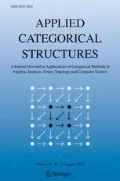Abstract
Within the framework of category theory, Cantor diagrams are introduced as the common structure of the self-reference constructions by Cantor, Russell, Richard, Gödel, Péter, Turing, Kleene, Tarski, according to the so-called Cantor diagonal method. Such diagrams consist not only of diagonal arrows but also of idempotent, identity and shift arrows. Cantor theorem states that no Cantor diagram is commutative. From this theorem, all the constructions above can be systematically retrieved. We do this by grouping them into two main classes: the class based on Cantor diagrams with a numerical shift function and the class based on Cantor diagrams with a Boolean shift function.
Similar content being viewed by others
References
Ackermann, W.: Zum Hilbertschen Aufbau der reellen Zahlen, Math. Ann. 99 (1928), 118–133.
Cantor, G.: Ñber eine Eigenshaft des Inbegriffs aller reellen algebraichen Zahlen, Journal für die Reine und Angewandte Mathematik 77 (1874), 258–262.
Cantor, G.: Ñber eine elementare Frage der Mannigkeitslehre, Jahresber. Deutsch. Math.-Verein. 1 (1890, 1891), 75–78.
Frege, G.: Grundgesetze der Arithmetik, Begriffschriftlih Abgeleitet, Vol. 2, Jena, 1903.
Frege, G.: Philosophical and Mathematical Correspondence, eds G. Gabriel et al., Blackwell, Oxford, 1980.
Germano, G.: Incompleteness theorem via weak definability of truth: A short proof, Notre Dame Journal of Formal Logic 14 (1973), 377–380.
Germano, G.: An arithmethical reconstruction of the liar's antinomy using addition and multiplication, Notre Dame Journal of Formal Logic 17 (1976), 457–461.
Germano, G. and Mazzanti, S.: Primitive iteration and unary functions, Annals of Pure and Applied Logic 40 (1988), 217–256.
Germano, G. and Mazzanti, S.: General iteration and unary functions, Annals of Pure and Applied Logic 54 (1991), 137–178.
Gonseth, F.: La vérité mathématique et la réalité, Enseign. Math. 31 (1933), 96–114.
Gödel, K.: Ñber formal unentscheidbare Sätze der Principia Mathematica und verwandter Systeme I, Monatshefte für Mathematik und Physik 38 (1931), 173–198.
Kleene, S. C.: General recursive functions of natural numbers, Mathematische Annalen 112 (1936), 727–742.
Kleene, S. C.: Introduction to Metamathematics, North-Holland, Amsterdam, 1952.
Lawvere, F. W.: Diagonal arguments and Cartesian closed categories, in P. Hilton (ed.), Category Theory, Homology Theory and Their Applications II, Proceedings of the Conference, Seattle Research Center of the Battelle Memorial Institute, 1968, Lecture Notes in Math. 92, Springer, Berlin, 1969.
Mac Lane, S.: Categories for the Working Mathematician, Springer-Verlag, New York, 1971.
Matijasevic, Yu. V.: Enumerable sets are diophantine, Soviet Math. Dokl. 11 (1970), 354–358.
Péter, R.: Konstruktion nichtrekursiver Funktionen, Mathematische Annalen 111 (1935), 42–60.
Richard, J.: Les principes des mathématiques et les problèmes des ensembles, Rev. Gén. Sci. Pures Appl. 16 (1905), 541–543; also in Acta Mathematica 30 (1906), 295- 296.
Richard, J.: Sur un paradoxe de la théorie des ensembles et sur l'axiome Zermelo, Enseign. Math. 9 (1907), 94–986.
Robinson, J.: General recursive functions, Proceedings of the American Mathematical Society 1 (1950), 703–718.
Robinson, R.: Primitive recursive functions, American Mathematical Society. Bulletin 53 (1947), 925–942.
Tarski, A. in collaboration with A. Mostowski and R. M. R. Robinson: Undecidable Theories, North-Holland, Amsterdam, 1953.
Turing, A.: On computable numbers, with an application to the entscheidungsproblem, Proceedings of the London Mathematical Society 42 (1936- 1937), 230–265.
Walters, R. F. C.: Categories and Computer Science, Cambridge Univ. Press, 1991.
Author information
Authors and Affiliations
Rights and permissions
About this article
Cite this article
Germano, G.M., Mazzanti, S. Cantor Diagrams: A Unifying Discussion of Self-Reference. Applied Categorical Structures 11, 313–336 (2003). https://doi.org/10.1023/A:1024447013739
Issue Date:
DOI: https://doi.org/10.1023/A:1024447013739




